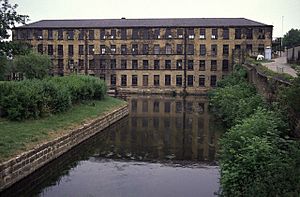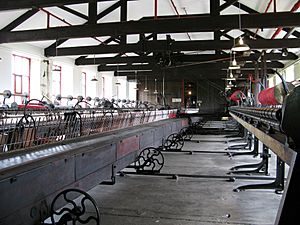Leeds Industrial Museum at Armley Mills facts for kids
The Leeds Industrial Museum at Armley Mills is a cool place to visit in Armley, near Leeds, in West Yorkshire, Northern England. It's a museum that shows what life was like during the time of big factories and machines, known as the Industrial Revolution. Here, you can see old machines used for making cloth, railway trains, and other amazing inventions.
This museum is in a very old building that was once the biggest wool factory in the world! It was built in 1805 by a man named Benjamin Gott. The factory stopped making wool in 1969. Then, Leeds City Council took it over and opened it as a museum in 1982. The museum is right next to the Leeds and Liverpool Canal and the River Aire. It's part of a group called Leeds Museums & Galleries, which also includes other fun places like Leeds Art Gallery and Leeds City Museum.
Contents
Where is Armley Mills Located?
Armley Mills sits on the south side of the River Aire. It's about 150 feet (46 meters) above sea level. A special wall, called a weir, was built upstream. This weir helped keep a lot of water flowing to power the big water wheels. Water from above the weir would go into a millpond. Then, it flowed under the main building and over the water wheels, making them spin.
The Leeds and Liverpool Canal was dug in 1777, right next to the mill. This was super helpful! It meant the mill had its own wharf. A wharf is like a dock where boats can load and unload things. So, raw materials like wool could arrive easily. Finished goods could be sent out, and later, coal for the steam engines could be brought in.
Close by, there was a place called Botany Bay Yard. It got this name because it was the first spot in England where wool from Botany Bay in Australia was brought ashore. There are still parts of the old unloading shed and what looks like a sunken boat next to the canal there.
A Look Back: History of Armley Mills
Early Days of the Mill
The first records of Armley Mills are from the mid-1500s. A local cloth maker, Richard Booth, rented "Armley Millnes." In 1707, they were called "fulling mills." Fulling was a dirty but important job. It made woven wool thicker and stronger. Large hammers, called fulling stocks, would repeatedly hit bundles of cloth. The cloth was soaked in water, urine, and a special clay called Fuller's earth. The urine was used because it had ammonia, which helped the process. People in nearby houses would even save their urine for the mill!
By 1788, the mills had grown a lot. They had five waterwheels that powered eighteen fulling stocks.
New Owners and a Big Fire
In 1788, the mills were sold to Colonel Thomas Lloyd. He was a cloth merchant from Leeds. He made the mill even bigger, turning it into the world's largest wool factory. He then rented it out to Israel and John Burrows.
But in 1804, a terrible fire burned the mills down. Old factories were often fire hazards. Tiny fibers in the air could easily catch fire, and the buildings themselves were made of wood.
Benjamin Gott Rebuilds
After the fire, Benjamin Gott bought the mills in 1804/1805. He rebuilt them using special "fireproof" ideas. This new building is the one you see today, and it's considered very important historically. Gott owned several wool factories. He passed away in 1840, and his sons, John and William, took over.
In 1850, they added a steam engine to help the water wheels. By the 1860s, the water wheels were no longer used.
The Mill's Later Years and Becoming a Museum
By 1907, parts of the mill were rented out to other businesses. A company called Bentley and Tempest, who made wool clothing, took over the mill. The museum even has a book that records accidents that happened during their time there.
The factory finally closed in 1969. This happened because technology was changing, and there wasn't as much demand for their products. Leeds City Council bought the mill. They then reopened it as a museum of industry in 1982.
The museum was damaged by a big flood on Boxing Day in 2015. But don't worry, it has been repaired and is open again!
Exploring the Buildings
The main parts of the museum buildings are from Benjamin Gott's 1805 construction. Some smaller parts were added later in the 1800s. There's even a little bit left of the old corn mill from 1795 that didn't burn down. The building is shaped like an "L" and is built on a slope. So, some parts are four stories tall, and others are two stories.
The mill was built to be fireproof. It has round cast iron columns that hold up brick floors. These floors are built like shallow arches. In the older parts that survived the fire, wooden beams were covered with sheet-iron to protect them.
The mill race, where the water flows, goes right under the main building. At water level, you can see six beautiful arches with iron grates. The mill from 1788 used five waterwheels. The 1805 mill used two large metal wheels. They were named Wellington and Blucher, after famous heroes fighting Napoleon at the time. These wheels were very powerful, about 70 horsepower each! A steam engine was added in 1855 to help. The big water wheels were removed in 1885, but we have old photos of them. There's also an older wooden wheel that powered the corn mill, but it needs fixing.
In 1805, this mill was the biggest wool factory in the world. It had 18 fulling stocks and 50 looms for weaving.
What You Can See: Museum Collections
Leeds was a very important industrial city in the 1700s and 1800s. The museum's collections show the history of industry in the city, both old and new. You can find old papers and objects from famous people like John Smeaton and Matthew Murray.
Textile Gallery: Making Cloth
This part of the museum shows you how wool was made into cloth. You can see the whole process, from raw wool to a finished blanket!
- Carding machine: This machine combs the wool fibers to get them ready for spinning.
- 1904 Platt Brothers & Co condensor mule: This is a special machine that spins wool into yarn. It still works!
- Warping machine with creel: This machine prepares the threads that go lengthwise in the fabric.
- Hattersley Standard Loom: A type of machine used for weaving cloth.
- Hollingworth Knowles of Dobcross Jacquard Loom: This loom was built based on a design from 1909. It was used until 1980!
- Blanket Loom: A large loom specifically for weaving blankets.
- Fulling stocks: These are the big hammers that beat the wool to make it thicker.
- Raising gig: This machine makes the blanket feel soft and fuzzy. It uses a drum with rows of teasels (a plant with prickly heads) to brush the fabric.
- Cropping machine: After the fabric is fuzzy, this machine trims the fuzz to an even height.
- Cutting machine: Wool cloth is heavy and can get damaged if rolled up. This machine folds the cloth neatly.
- Pressing machine: This machine uses hydraulic power to press the fabric flat.
Railway Collection: Trains and More!
The museum has a large collection of old trains and railway equipment. This collection started in 1956. There's even a short railway line at Armley where some of the trains can run!
Locomotives
Here are some of the cool locomotives you might see:
| Name | Builder | Gauge | Wheel arrangement |
Date | Works number | Notes |
|---|---|---|---|---|---|---|
| Barber | Thomas Green & Son | 2 ft (610 mm) | 0-6-2T | 1908 | From the Harrogate Gas Works Railway. It's currently on loan to the South Tynedale Railway. | |
| Jack | Hunslet Engine Company | 18 in (457 mm) | 0-4-0WT | 1898 | 684 | Acquired in 1957. |
| Lord Granby | Hudswell Clarke | 3 ft (914 mm) | 0-4-0ST | 1902 | Acquired in 1961. | |
| Junin | Hudswell Clarke | 2 ft 6 in (762 mm) | 2-6-2DM | 1930 | A diesel locomotive from the Junin railway in Chile. | |
| Southam 2 | Hudswell Clarke | 4 ft 8 1⁄2 in (1,435 mm) | 0-4-0DM | 1942 | D625 | Used to work at Rugby Cement in Southam, Warwickshire. |
| E. B. Wilson and Company | 4 ft 8 1⁄2 in (1,435 mm) | 0-6-0 | 1855 | Parts of an old train from 1855. It was used for teaching until 1964. It's currently taken apart. |
Amazing Models
The museum also has some very important models. This includes the oldest model locomotive in the world! It was built by Matthew Murray in 1811. It was a test model for a real train called Salamanca.
More to Explore
- Listed buildings in Leeds (Armley Ward)
- British narrow gauge railways



